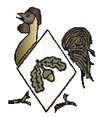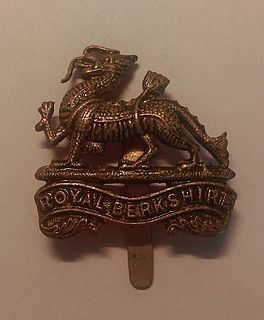Related Research Articles

The Royal Welch Fusiliers was a line infantry regiment of the British Army and part of the Prince of Wales' Division, founded in 1689 shortly after the Glorious Revolution. In 1702, it was designated a fusilier regiment and became The Welch Regiment of Fusiliers; the prefix "Royal" was added in 1713, then confirmed in 1714 when George I named it The Prince of Wales's Own Royal Regiment of Welsh Fusiliers. After the 1751 reforms that standardised the naming and numbering of regiments, it became the 23rd Foot.

The 19th (Western) Division was an infantry division of the British Army, part of Kitchener's Army, formed in the Great War.

The Welch Regiment was an infantry regiment of the line of the British Army in existence from 1881 until 1969. The regiment was created in 1881 under the Childers Reforms by the amalgamation of the 41st (Welch) Regiment of Foot and 69th Regiment of Foot to form the Welsh Regiment, by which it was known until 1920 when it was renamed the Welch Regiment. In 1969 the regiment was amalgamated with the South Wales Borderers to form the Royal Regiment of Wales.

The King's Shropshire Light Infantry (KSLI) was a light infantry regiment of the British Army, formed in the Childers Reforms of 1881, but with antecedents dating back to 1755. It served in the Second Boer War, World War I and World War II. In 1968, the four regiments of the Light Infantry Brigade amalgamated to form The Light Infantry, with the 1st KSLI being redesignated as the 3rd Battalion of the new regiment.

The 40th Division was an infantry division of the British Army active during the First World War, where it served on the Western Front. It was a division of Lord Kitchener's New Army volunteers, mostly "bantam" recruits of below regulation height. It was later briefly reformed as a fictional deception formation in the Second World War, and during the early years of the Cold War was recreated a third time to garrison Hong Kong.

The Wiltshire Regiment was a line infantry regiment of the British Army, formed in 1881 under the Childers Reforms by the amalgamation of the 62nd (Wiltshire) Regiment of Foot and the 99th Duke of Edinburgh's (Lanarkshire) Regiment of Foot.

The Royal Berkshire Regiment was a line infantry regiment of the British Army in existence from 1881 until 1959. The regiment was created in 1881, as the Princess Charlotte of Wales's , by the amalgamation of the 49th (Hertfordshire) Regiment of Foot and the 66th (Berkshire) Regiment of Foot. In 1921, it was renamed the Royal Berkshire Regiment .

The Royal Wiltshire Yeomanry (RWY) was a Yeomanry regiment of the Kingdom of Great Britain and the United Kingdom established in 1794. It was disbanded as an independent Territorial Army unit in 1967, a time when the strength of the Territorial Army was greatly reduced. The regiment lives on in B and Y Squadrons of the Royal Wessex Yeomanry.

The 158th Infantry Brigade was an infantry brigade of the British Army that served in both the First and Second World Wars, before being disbanded in 1968. Throughout its existence the brigade was assigned to the 53rd (Welsh) Infantry Division and was composed almost entirely of Territorial battalions from the Royal Welch Fusiliers.

The 21st Brigade was an infantry brigade formation of the British Army.
The 47th Brigade was a formation of British Army. It was part of the new army also known as Kitchener's Army. It was assigned to the 16th (Irish) Division and served on the Western Front during the First World War.
The 40th Brigade was a formation of the British Army. It was one of the new army or Kitchener's Army brigades, and assigned to the 13th (Western) Division and served in the Gallipoli and the Mesopotamian campaign during the First World War.
The 67th Brigade was an infantry brigade of the British Army. It was raised as part of the New Army, also known as Kitchener's Army and assigned to the 22nd Division and served on the Western Front and the Macedonian Front during the First World War.
The 79th Brigade was a formation of the British Army. It was raised as part of the new army also known as Kitchener's Army and assigned to the 26th Division and served on the Western Front and the Macedonian Front during the First World War.
The 84th Brigade was a formation of the British Army. It was originally formed from regular army battalions serving away from home in the British Empire. It was assigned to the 28th Division and served on the Western Front and the Macedonian Front during the First World War. The Brigade was temporarily attached to the 5th Division between March and April 1915.

The 135th Infantry Brigade was an infantry brigade of the Territorial Force, part of the British Army. It was formed in the First World War as a duplicate of the South Western Brigade and was originally formed as the 2nd/1st South Western Brigade in 1914–1915 before later being renamed as the 135th Brigade. It was sent overseas to India in December 1914 to relieve Regular Army units for service in France. The brigade remained there for the rest of the war, supplying drafts of replacements to the British units fighting in the Middle East and later complete battalions.
The 114th Brigade was an infantry brigade formation of the British Army during the Great War. It was raised as part of the new army also known as Kitchener's Army and assigned to the 38th (Welsh) Division.
The 119th Brigade, originally the Welsh Bantam Brigade, was an infantry brigade formation of the British Army during World War I. Part of Lord Kitchener's 'New Armies', it served in the 40th Division on the Western Front. The brigade number was reactivated for deception purposes during World War II.

The British yeomanry during the First World War were part of the British Army reserve Territorial Force. Initially, in 1914, there were fifty-seven regiments and fourteen mounted brigades. Soon after the declaration of war, second and third line regiments were formed. However, the third line regiments were soon absorbed into the Cavalry Reserve Regiments, to supply replacements for the cavalry and yeomanry. Other horsed regiments in the British Army, during the war, were the regular cavalry regiments and the three regiments belonging to the special reserve: the North Irish Horse, the South Irish Horse and the King Edward's Horse. The senior yeomanry regiments could trace their origins back over 100 years; the oldest regiment, the Royal Wiltshire Yeomanry, had been formed in 1794. The most junior regiment, the Welsh Horse, had only been formed on 18 August 1914, after the start of the war.
The 1st South Western Mounted Brigade was a formation of the Territorial Force of the British Army, organised in 1908. By 1915 its regiments had been posted away so it was broken up; it never saw active service as a brigade. The Headquarters may have formed the HQ for 2/1st Southern Mounted Brigade.
References
- ↑ "19th (Western) Division". The Long Long Trail. Retrieved 20 January 2012.
| This article about a specific British military unit is a stub. You can help Wikipedia by expanding it. |